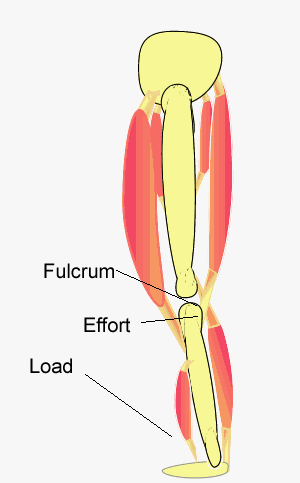Before commencing click to refresh your knowledge on levers.
The human skeleton forms a set of levers operated by the many muscles attached to them. Three different types of levers exist. They are known as first order, second order and third order levers.
All levers have a fulcrum, point of rotation. Depending on where the load and the effort are, relative to the fulcrum, determines the type of lever.
Most levers in the body are third order levers designed to maximise the speed rather than maximise the force.
Muscles are connected to bones by tendons. Often these tendons are located close to joints. A minimal contraction by the muscle results in maximum movement of the bone. Muscle can only contract and relax. Once contracted they must be pulled back to their original length. For this reason most muscles act in pairs known as antagonistic pairs. Each muscle in the pair acts in the opposite way to the other.

The many muscles in the body can be grouped into 7 groups.
1) Protractor muscles pull
the limb forwards.
2) Retractor muslces pull the limb backwards.
3) Adductors pull the limb towards the body.
4) Abductors pull the limb away from the body.
5) Rotators swivel the limb at the joint.
6) Flexors pull two parts of a limb close together at the joint.
7) Extensors pull two parts of the limb away from each other at the joint.
When the hamstring contracts it is acting as an
The lower part of the leg is controlled by the thigh muscle and the hamstring. The lever that is formed is
When the calf muscle contracts it pulls the back of the foot upwards. What type of lever is this? Explain where the load, fulcrum and effort are situated.

The biceps muscle can best be classified as an
The triceps muscle can best be described as an
The calf muscle acts to pull the foot upwards. Consider the animation above. The foot and calf muscle form a . Draw a picture of the joint and locate the fulcrum, load and effort.